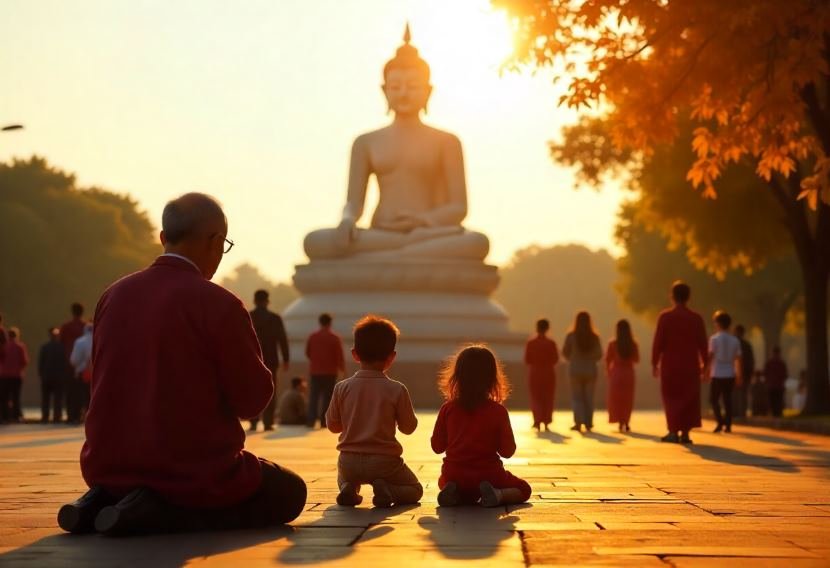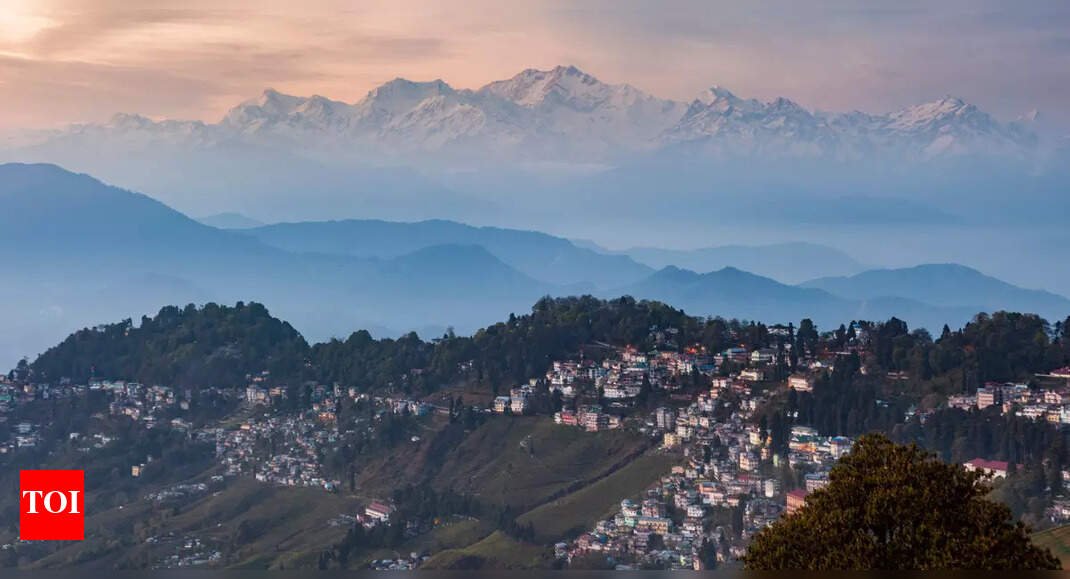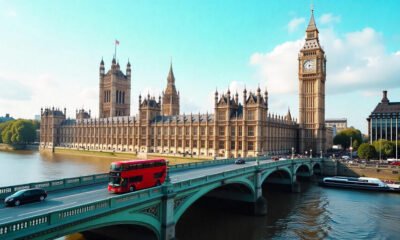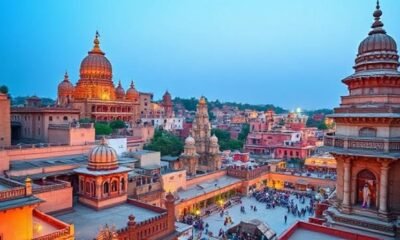Travel Guides & Articles
India Reopens Doors to Chinese Tourists with E-Visas: Agra, Delhi, Bodh Gaya Set for Massive Tourism Surge

Saturday, July 26, 2025
India officially restarts issuing e-visa to Chinese nationals after nearly five years, the Indian embassy announced. It is the first important move ending a freeze on visas after the pandemic and worsening border tensions, and reflects the success of talks between the foreign and home ministries over the past few months. With the renewed friendship of these two nations, India will also be reopening its border to tourism with China, which will create new opportunities for cross-cultural tourism, business relationships and spiritual tourism. This represents a critical time to build people-to-people links and the iconic Indian cities including Agra, Delhi and Bodh Gaya are expected to receive the maximum number of Chinese tourists.
In tandem with India’s move, Chinese authorities have reopened the sacred pilgrimage route to Mount Kailash and Lake Manasarovar in Tibet for Indian pilgrims. These spiritual landmarks, significant to Hindus, Buddhists, and Jains, were closed to Indian visitors for years, adding an emotional and spiritual dimension to the renewed ties between the two nations. Together, these two developments signal a brighter future for tourism between India and China, with spiritual and cultural tourism taking center stage in fostering mutual understanding and trust.
The Revival of Chinese Tourism to India
Before the pandemic, Chinese nationals accounted for nearly 27% of India’s inbound tourism, with around 300,000 arrivals recorded in 2019 alone. The renewed visa regime is expected to jumpstart India’s tourism sector, which is still recovering from the pandemic’s impact. Tour operators are optimistic that the return of Chinese visitors will breathe new life into cultural tourism, particularly in spiritual circuits and heritage destinations that have long appealed to Chinese tourists.
India is home to numerous destinations of historical, spiritual, and cultural significance that have drawn Chinese visitors for years. The allure of India’s rich heritage, intertwined with Buddhism and ancient history, makes it a top destination for those seeking to explore the roots of spiritual teachings. With the e-visa now available, Chinese nationals can easily apply online through the official Indian visa portal, book an appointment, and submit their documents at designated centres in Beijing, Shanghai, or Guangzhou, making travel more accessible than ever before.
Spiritual and Heritage Destinations That Appeal to Chinese Tourists
Bodh Gaya, Bihar
Buddhists from China and from around the world have often flocked to Bodh Gaya, where the Buddha found enlightenment. The Mahabodhi Temple, a world heritage site of UNESCO, attracts thousands of visiting Chinese Buddhist pilgrims every year. Not far from Bodh Gaya, other spiritual sites like Nalanda, Rajgir and Vaishali have followed suit, now important waypoints in India’s expanding Buddhist tourism circuit. Not only do these sacred sites hold profound spiritual meaning, they are learning institutions for anyone wanting to learn more about Buddhism’s history and teachings.
Golden Triangle: Delhi, Agra, Jaipur
The Golden Triangle, encompassing Delhi, Agra, and Jaipur, is another popular circuit for Chinese tourists, offering a mix of cultural, architectural, and historical wonders. In Agra, the Taj Mahal remains one of the most iconic attractions, drawing millions of visitors annually. The Qutub Minar in Delhi, along with the historic forts and palaces of Jaipur, are also key highlights for Chinese tourists, who traditionally flock to these destinations in group tours. The combination of spiritual significance and architectural marvels makes the Golden Triangle an essential part of the Chinese tourist itinerary in India.
Buddhist Circuit and Swadesh Darshan Scheme
India’s Swadesh Darshan scheme, which aims to promote tourism in lesser-known but culturally significant areas, includes several Buddhist circuit routes. These routes connect spiritual destinations across various states, creating a comprehensive tour that traces the life and teachings of Buddha. The routes not only cater to Buddhist pilgrims but also attract tourists interested in India’s spiritual history. The expansion of the Buddhist circuit, integrated into India’s broader tourism plans, is expected to see a surge in Chinese visitors, particularly those looking for an immersive spiritual experience.
The Kailash Manasarovar Yatra and Cultural Exchange
In addition to India’s visa resumption, Chinese authorities have lifted restrictions on the Kailash Manasarovar Yatra, allowing Indian pilgrims to once again embark on this sacred journey to Tibet. Mount Kailash and Lake Manasarovar are revered by Hindus, Buddhists, Jains, and Tibetans, making the reopening of this pilgrimage route a highly symbolic gesture in strengthening cross-border cultural and spiritual ties. For many Indian pilgrims, the chance to visit these sacred sites has been a long-awaited opportunity, and the reopening is expected to foster greater cultural exchange and religious harmony between the two nations.
How to Apply for an E-Visa to India
For Chinese nationals looking to visit India, applying for an e-visa is now a seamless process. Travelers can apply online through the official visa portal, where they will need to provide the necessary documents and book an appointment at the designated visa centres in Beijing, Shanghai, or Guangzhou. With the implementation of e-visas, the application process is more convenient than ever, paving the way for a smoother travel experience.
Conclusion: A New Era of India-China Tourism
The restarting of e-visas with Chinese nationals and the reopening of the Kailash Manasarovar Yatra route mark the ushering of a new era of India-China relationship. With both countries eyeing spiritual and cultural tourism as the way forward to mend relations, major tourist destinations like Agra, Delhi, Bodh Gaya are set to witness exponential increase in Chinese footfall. This measure serves not only to boost tourism, but also enhances the understanding and respect between ordinary people. However, as travel restrictions are lifted and spiritual tourism increases, India and China have once more begun to discover the power of shared heritage to overcome divisions and build a stronger and more hopeful future.
Travel Guides & Articles
Are UAE airports rejecting passengers over minor passport damage? Here’s why this matters for your travel plans | World News

Travellers flying from the UAE are being warned: even a slightly worn passport can now stop you from boarding. As immigration and airline checks tighten, minor wear and tear, such as frayed edges, water stains, or a scratched chip, is enough to get a valid passport rejected, regardless of visa status.
Passport wear can mean denied boarding, even with a valid visa
International travellers departing from Dubai, Abu Dhabi, and Sharjah are facing increased scrutiny over the physical condition of their passports. UAE-based airlines are now enforcing stricter rules, often stopping passengers at check-in if their passports show even minor damage, regardless of visa validity or passport expiry date. Common types of damage that can raise red flags include:
- Frayed corners
- Torn pages
- Water or coffee stains
- Loose binding
- Scratched or faulty data chips
- Peeling laminate
- Visible smudges, especially on the photo page
Authorities say these issues, though sometimes minor, may compromise embedded security features such as microchips, holograms, and machine-readable zones. If these features are damaged, passport scanners may fail, leading to suspicion of forgery or tampering by immigration officers. Airlines departing from the UAE are also held accountable. If a passenger is denied entry due to passport condition, the airline may face penalties or be required to bear the cost of deportation. This has made airlines extra cautious at the check-in stage, often barring travellers with visibly damaged passports from boarding at all.
Countries with the strictest passport integrity checks
While the UAE is leading this push for pristine passports, other countries are also enforcing similar measures. The following nations are particularly strict about the condition of travel documents:
- United Arab Emirates:
Passports with loose pages, damage to the binding, deep creases, or water exposure can be flagged. Airline staff are instructed to examine documents closely before allowing boarding. - Indonesia:
Even a 1-centimetre tear in any passport page may lead to refusal of entry. Indonesian immigration officers maintain a zero-tolerance approach toward damaged documents. - Thailand & Vietnam:
Any form of water damage, especially on the photo page, can result in entry denial. Cosmetic flaws are taken seriously. - United States:
Given the reliance on biometric verification and chip scanning, a scratched or non-functional chip can render a passport invalid. Border officials treat compromised passports as potential forgery risks. - Australia:
Immigration guidelines advise travellers to avoid flying with passports that show visible damage of any kind. Airline personnel have the discretion to deny boarding at check-in.
What counts as “damaged” and when to replace your passport
Officials generally split passport damage into two categories:
- Partially Damaged:
The personal details and photo remain legible, but the document has torn pages, stains, or surface damage. Even in this state, rejection is still possible at check-in or immigration. - Severely Damaged:
The passport’s photo or key information is obscured or unreadable. This renders the document unusable for international travel.
Even a partially damaged passport can lead to denial of boarding or entry. Travellers are strongly advised to renew their passport at the first signs of wear, before problems occur. Prevention is key: keeping the document dry, using a protective cover, and avoiding inserting papers or folding the passport helps maintain its integrity.
Why authorities are so strict, the risk of tampering
Modern passports are more than just identification; they are high-security documents embedded with:
- Microchips
- Holograms
- Machine-readable zones
Damage to any of these features can cause technical issues at automated border control gates or manual inspection points. A passport that fails to scan correctly could appear tampered with, triggering suspicion and potential detainment. Officials emphasize that the strict enforcement is to protect national security and maintain document integrity. With the rise in identity fraud and document forgery, immigration systems are designed to flag any inconsistencies, no matter how small.
Travel Guides & Articles
Rajasthan Tourism Partners With FlixBus To Roll Out Culture-Themed Buses On These Routes In India & UK

Rajasthan’s heritage has just found itself a new stage, on the sides of buses. From the steps of Jaipur’s Albert Hall Museum on Wednesday, Deputy Chief Minister Diya Kumari flagged off Rajasthan-themed FlixBuses, their exteriors drenched in images of forts, palaces, and folk motifs, ready to turn heads in both the United Kingdom and India.
Rajasthan-Themed FlixBuses Flagged Off From Jaipur
Hon’ble Deputy CM of Rajasthan, Ms. Diya Kumari flagged off the FlixBus Heritage on Wheels initiative at Albert Hall, joined by Commissioner of Tourism Mrs. Rukmani Riar-IAS, and Managing Director of FlixBus India Mr. Surya Khurana.@KumariDiya #HeritageOnWheels #DiyaKumari
(1/2) pic.twitter.com/FijCHDoy5B— Rajasthan Tourism (@my_rajasthan) September 10, 2025
According to Travel Trade Journal, the idea, as said by Divya Kumari, is not just about transport but about storytelling on wheels. She reiterated that Rajasthani culture and heritage are the soul of their identity. She added that they want travellers from across the world to experience this essence. These buses will serve as moving ambassadors, showcasing their traditions and tourism potential. This initiative will enhance their global image, open new opportunities for the youth, and contribute to economic growth.
The collaboration was first sparked during Divya Kumari’s visit to Munich under the Rising Rajasthan initiative. Months later, it’s hitting the road in two high-visibility corridors: the London-Cambridge route in the UK, and the Dehradun-Haridwar-Delhi-Jaipur stretch in India.
But these buses are more than rolling posters. A quick scan of the QR codes printed on their sides opens the Rajasthan Tourism website, where travellers can browse itineraries, read about heritage landmarks, or even plan a trip to Jaipur straight from their seat.
Beyond Forts And Palaces
For FlixBus, the project is an experiment in marrying mobility with culture. Surya Khurana, Managing Director of FlixBus, said that this initiative connects heritage with modern travel experiences. He further added that they wish for passengers to enjoy more than just a journey, and want them to experience the richness of Rajasthan’s history and culture firsthand.
To make the debut tangible, the first 100 passengers rolling into Jaipur on these buses will get free entry to the Albert Hall Museum, the very site where the initiative was launched. Social media campaigns and calls for user-generated content will extend the buzz online, ensuring the buses’ cultural messaging doesn’t stop at the roadside.
Also Read: Travelling To Ranthambore? 7 Animals You Can Sight At This National Park In Rajasthan
All You Need To Know
Divya Kumari used the launch to stress that Rajasthan’s tourism identity must stretch beyond its postcard landmarks. The buses, she said, are a way to remind travellers that the state’s richness lies as much in its living traditions and diverse experiences as in its monumental architecture, as stated by Travel Trade Journal.
Themed buses are a bold step in experiential marketing, pushing Rajasthan’s image into everyday spaces like highways and bus stations. They make the state visible not just at travel expos or ads, but to commuters, tourists, and locals alike. By fusing cultural imagery with upbeat infrastructure, the government hopes to bring in new audiences, generate jobs, and place Rajasthan more firmly on the global travel map.
In Divya Kumari’s words, the buses are “moving ambassadors.” In practice, they’re something more: a signal that Rajasthan Tourism is ready to take its story wherever the road leads.
Cover Image Courtesy: tweetkishorec/X
For more such snackable content, interesting discoveries and the latest updates on food, travel and experiences in your city, download the Curly Tales App. Download HERE.
First Published: September 13, 2025 5:04 PM
Travel Guides & Articles
Why Northeast India needs to be on top of India’s tourism map this year |

Vacationing in India, is always about wandering off to the dry deserts in Rajasthan to the huge lagoons of Kerala to snow-capped peaks of Himachal. Despite all this, the Northeastern part of India is quite unexplored and has some of the most breathtaking landscapes and cultural treasures of the country. This part, including the so-called seven sisters: Arunachal Pradesh, Assam, Manipur, Meghalaya, Mizoram, Nagaland, and Tripura-Apart from Sikkim-has finally been put on the map for must-visits.
Raw, Untouched Nature
The North East of India is probably a land of the last unknown natural landscapes and undisturbed raw beauty. From rolling tea gardens of Assam to the ethereal living root bridges in Meghalaya, those from Kanchenjunga-housed Sikkim to Arunachal’s mystical-yet-iconic monasteries realize that the region indeed gives you every type of landscape imaginable. Those addicted to nature can trek through alpine meadows, visit dense forests abundant in biodiversity, or take river cruises on the mighty Brahmaputra. Away from the commercialized tourist circuits, the Northeast has that remaining charm and tranquility to retain.
A Cultural Kaleidoscope
The Northeast is a mix of all ethnicities, customs, and languages. Over 200 tribes inhabit this set of states, each practicing its local customs, dyeing, and craft; festivals and culinary flavors; it is an experience all by itself. The festivals like Hornbill of Nagaland, Sangai of Manipur, or Bihu of Assam offer spectacular glimpses into day-to-day life. Here one may sample native art forms, folk music, and crafts that are very ancient but stand apart from mainstream Indian culture.Read more: Beyond Marine Drive: 10 Mumbai parks best for family outing
Adventures Await
This is the region for adrenaline junkies. Right from cave explorations in Meghalaya to white-water-rafting in Arunachal, paragliding in Sikkim, or mountain biking on tough tracks in Nagaland, this part of North East India truly has it all for adrenaline junkies. The untouched terrain safeguards the purity of any such adventure experience across here.
Sustainable and Responsible Tourism
Conscious traveling is hitting zeniths, and drawing up an ecology road for the North East is a classic example of sustainable travel. The region’s community, deep-minded of ecology, has been carrying out ecologically conscious life for centuries. Choosing from different modes of responsible tourism is one of doing the eco-homestays, eco-camps that save the environment while restoring a livelihood for the locals.
Exploring Culinary Delights
North East denotes a plethora of culinary traditions, with each being a figure of a particular cultural identity. Each state has its culinary specialties-from from Assam fish curries that are sour and hot, to smoked meat and chilling atmosphere of Nagaland; from jadoh rice of Meghalaya, to momos and thukpa of Sikkim that are highly famous. Neither a few fresh herbs here, nor a couple of bamboo shoot there, in combination with those local spices, would guarantee that the food is worth reminiscing. So for those wanting to taste some real, off-the-beaten-path flavors-the region is a ready-made paradise to go to.Read more: 8 incredible safari tours around the world that aren’t about Big Cats
Boosting Connectivity and Infrastructure
Now with the availability of direct flights to such destinations from prime locations in the country such as Delhi, Mumbai, and Bengaluru, it is better observed with more accessibility. Improved road network, new airports, improved rail connectivity are all making the region ever more accessible. The “Act East Policy” of the government has also ensured increased investments for infrastructure, further opening gates for tourism. Easy access has been made possible currently because of new direct flights from metropolitan cities such as Delhi, Mumbai, and Bengaluru.
The Traveler’s Safe Haven
Perhaps due to not very many people being aware of the site, the Northeast really answers the description of a safest and most hospitable land for any traveler to venture into. The Northeast people, friendly and accommodative, are ever willing to share their culture with the outsiders. Single travelers, more often than not, especially female ones, rave about the safety and the sense of belonging they experienced when traveling in the region.
The Foreign Edge in Tourism
With international places becoming too pricey, North-East India can offer experiences at a fraction of the cost. It offers a pristine beauty that can compete with the alpine meadows of Switzerland; its wildlife sanctuaries can give others a run for their biodiversity; and its cultures are rich, rivaling Southeast Asia—all the while, making travel easier for the already home-based tourist. So, the place remains a hot cake not only for domestic tourism but also for international tourism. In many ways, North East India is no longer the “hidden gem” of India; instead, it is all set to steal the limelight in the tourism map of the country. In 2025, the spotlight will fall on the region as one that truly blends nature, culture, adventure, and accessibility. The North East is not just a destination but a genuineness, sustainable, and truly memorable travel alternative.Author:
Mr. Ravi Gosain, President, Indian Association of Tour Operators (IATO)
-

 Business2 weeks ago
Business2 weeks agoThe Guardian view on Trump and the Fed: independence is no substitute for accountability | Editorial
-
Tools & Platforms1 month ago
Building Trust in Military AI Starts with Opening the Black Box – War on the Rocks
-

 Ethics & Policy2 months ago
Ethics & Policy2 months agoSDAIA Supports Saudi Arabia’s Leadership in Shaping Global AI Ethics, Policy, and Research – وكالة الأنباء السعودية
-

 Events & Conferences4 months ago
Events & Conferences4 months agoJourney to 1000 models: Scaling Instagram’s recommendation system
-

 Jobs & Careers2 months ago
Jobs & Careers2 months agoMumbai-based Perplexity Alternative Has 60k+ Users Without Funding
-

 Podcasts & Talks2 months ago
Podcasts & Talks2 months agoHappy 4th of July! 🎆 Made with Veo 3 in Gemini
-

 Education2 months ago
Education2 months agoMacron says UK and France have duty to tackle illegal migration ‘with humanity, solidarity and firmness’ – UK politics live | Politics
-

 Education2 months ago
Education2 months agoVEX Robotics launches AI-powered classroom robotics system
-

 Funding & Business2 months ago
Funding & Business2 months agoKayak and Expedia race to build AI travel agents that turn social posts into itineraries
-

 Podcasts & Talks2 months ago
Podcasts & Talks2 months agoOpenAI 🤝 @teamganassi





















